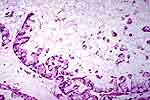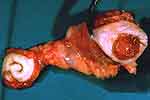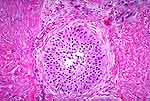 |
Figure 1: Most urachal carcinomas will have this
appearance: fragments of adenocarcinoma (Fig. 1) or signet ring cells
(Fig. 2), floating in large lakes of mucin. |
 |
Figure 2: Urachal carcinoma. Signet ring cells
floating in large lakes of mucin. |
 |
Figure 3: This illustrates a typical surgical
specimen from a case of urachal carcinoma. The tumor (right) protrudes
into the bladder lumen at the dome. The entire urachal tract has been
excised, up to and including the umbilicus (left side). |
 |
Figure 4: This specimen shows bladder and bladder
neck at the right and a large, necrotic, and mucoid tumor at the left,
above the bladder. |
 |
Figure 5: This is a urachal remnant, composed of
urothelium, deep within the muscularis propria. |
 |
Figure 6: Muscularis propria is seen at the top
and bottom. Running through it, in a linear fashion, are benign urachal
remnants. Most show glandular metaplasia but several (arrows) are lined by
urothelium. Obviously, had a tumor been present, we would suspect a
urachal origin. |

